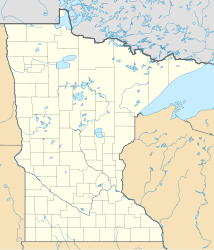The Minnesota Bureau of Criminal Apprehension (BCA) is a statewide criminal investigative bureau headquartered in Saint Paul that provides expert forensic science and criminal investigation services. The BCA assists local Minnesota law enforcement agencies with complex investigations using the latest technology and techniques, and BCA personnel help secure arrests for violence-related and drug-trafficking crimes, among others.[2] Notably, the BCA investigates killings by police and similar incidents.[3]
| Minnesota Bureau of Criminal Apprehension | |
|---|---|
| Abbreviation | BCA |
| Agency overview | |
| Formed | 1927 |
| Employees | 533 |
| Jurisdictional structure | |
| Operations jurisdiction | Minnesota, U.S. |
 | |
| Map of Minnesota Bureau of Criminal Apprehension's jurisdiction | |
| Size | 86,936 square miles (225,160 km2) |
| Population | 5,576,606 (2017 est.) |
| Legal jurisdiction | State of Minnesota |
| Operational structure | |
| Headquarters | 1430 Maryland Ave E Saint Paul, MN 55106 |
| Agency executives |
|
| Parent agency | Minnesota Department of Public Safety |
| Divisions |
|
| Website | |
| dps.mn.gov | |
The BCA operates as a subsidiary division of the Minnesota Department of Public Safety,[2] a major state agency of the Minnesota Executive Branch.[4] The BCA's current Superintendent is Drew Evans.[1][5]
History
editThe Bureau of Criminal Apprehension (BCA) was created by the Minnesota Legislature in 1927 in order to assist police departments statewide to solve crimes and apprehend criminals, under the direction of the Minnesota Attorney General's office. The BCA gathers crime statistics to assist state and local agencies to identify criminal trends. In 1935, agents received full police power and were licensed police officers throughout the state. In 1947, the BCA Crime Lab was established in St. Paul to assist in solving of crimes via forensic science, and was one of the first DNA laboratories in the United States in 1990.[6] Later the BCA was the first law enforcement agency in the United States to identify a suspect solely on DNA. In 1969, the agency was moved under direction of the State Attorney General's Office to the Minnesota Department of Public Safety. In 2001, the BCA opened an additional forensic laboratory in Bemidji. Additionally, the BCA's Special Investigations Unit would collaborate with federal agencies to aid in multi-jurisdictional criminal investigations.[2] In 2004, the Bureau became one of four laboratories in the United States selected by the Federal Bureau of Investigation to serve as a regional mitochondrial DNA laboratory.
Divisions
editForensic Science Services
editThe BCA Forensic Science Services (FSS) provides forensic science expertise to law enforcement agencies statewide and to the FBI. This includes crime scene processing, digital and multimedia evidence collection, DNA collection and processing, forensic firearm examination, fingerprint identification, Toxicology, Trace evidence, breath alcohol instrument calibration, and chemical testing.[7]
Investigative Division
editThe Investigative Division provides criminal investigative assistance to law enforcement agencies statewide. BCA agents and analysts are positioned in two regional offices in St. Paul and Bemidji, along with 11 field offices located in Alexandria, Brainerd, Duluth, Grand Rapids, Mankato, Marshall, Moorhead, Rochester, Roseau, St. Cloud and Willmar. Services include crime scene investigations, cold case assistance, human trafficking investigations, predatory offender investigations, use-of-force and conflict investigations,[8] and special operations.
Minnesota Justice Information Services (MNJIS)
editThe Minnesota Justice Information Services (MNJIS), manages information between sources of criminal justice data for law enforcement agencies and criminal investigation agencies to help solve crimes via statistics and analysis.[9]
Professional Services
editProfessional Services provides training to law enforcement and investigation agencies to assist in crime scene investigation and investigation of crimes. In addition, assists in missing persons and the State's Amber alert system.[10]
See also
editReferences
edit- ^ a b "About - Leadership Team". Minn. Dep't of Public Safety: Bureau of Criminal Apprehension. Archived from the original on September 23, 2023. Retrieved 17 January 2024.
- ^ a b c Panlener, Robin (ed.). "Bureau of Criminal Apprehension" (PDF). Minnesota Guidebook to State Agency Services. 2004–2007. Saint Paul, Minnesota: State of Minnesota, Department of Administration, Communications Media Division, Minnesota’s Bookstore: 253–254. ISSN 1061-0987. Retrieved 17 January 2024.
- ^ Bogel-Burroughs, Nicholas (7 April 2021). "What is the Minnesota Bureau of Criminal Apprehension, the agency that investigated George Floyd's death?". The New York Times.
Since 2014, it has also investigated all police killings by the Minneapolis Police Department and other 'critical incidents,' such as when someone dies in custody.
- ^ Minnesota House Research Department (September 2012). "Creation and Organization of Executive Branch Agencies". Minnesota Legislature. Archived from the original on October 3, 2023. Retrieved 17 January 2024.
- ^ "Building Trust: A Conversation with Drew Evans". Minneapolis Foundation. Retrieved 2022-09-12.
- ^ "'An incredibly powerful tool,' DNA database, turns 30". MPR News. Retrieved 2022-09-12.
- ^ "Department of Public Safety - Public Safety Program: Bureau of Criminal Apprehension" (PDF). Governor's Revised Budget Recommendations. 2024–25. Minnesota Management and Budget: 113–121. March 2023.
- ^ Tribune, Rochelle Olson Star. "Under fresh scrutiny, BCA's Force Investigations Unit hits one-year mark soon with plenty of work on police shootings". Star Tribune. Retrieved 2022-09-12.
- ^ 2021–2023 Strategic Plan (PDF), Minnesota Bureau of Criminal Apprehension, archived from the original (PDF) on 2023-08-01, retrieved 2024-01-17
- ^ "Home". AMBER Alert. Retrieved 2022-09-12.